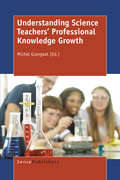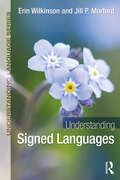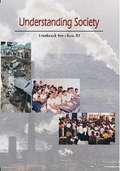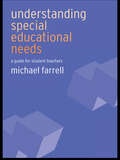- Table View
- List View
Understanding Science: Forces & Electricity (PDF)
by Penny JohnsonUnderstanding Science is a series of topic-based study books for Key Stage 2, providing comprehensive coverage of key subject areas. Forces & Electricity covers the following topics: electricity and circuits, magnets, measuring forces, friction, water and air resistance, machines and gears.
Understanding Science: Light, Sound & Space (PDF)
by Penny JohnsonUnderstanding Science is a series of topic-based study books for Key Stage 2, providing comprehensive coverage of key subject areas. Light, Sound & Space covers the following topics: light and sound travel, reflection, shadows, vibration, pitch, volume, the Earth, Sun, Moon and solar system.
Understanding Science: Our Bodies (PDF)
by Penny JohnsonUnderstanding Science is a series of topic-based study books for Key Stage 2, providing comprehensive coverage of key subject areas. Our Bodies covers the following topics: human life cycles, puberty, human digestive and circulatory systems, teeth, muscles, skeletons, diet, drugs and medicines.
Understanding Science Teachers’ Professional Knowledge Growth
by Michel GrangeatScience education has to be improved in order to become more responsive to the needs of society confronted with a rapidly changing world. Bringing science teaching up to a higher level is a key factor in this endeavour. The authors of this book think about teachers as part of the immediate and large communities and systems in which they function. They consider the development of teachers' professional knowledge as a continuous process that depends on the communities they are committed to and participate in, the discipline they are teaching, the social context in which they perform, the instruments made available in their environment, and their day-to-day classroom experience. From this perspective, each teacher learns in an individual way, but cannot learn without relying on their colleagues and other partners. Such professional knowledge is partly tacit and explicit, and thus possessed by teachers, experts and researchers. Coordinating activity theory and models of pedagogical content knowledge (PCK), the book provides a better understanding of the growth of science teacher professional knowledge. The chapters are organised around shared perspectives and themes and based on research findings. The emerging model can inform pre-service teacher educators, researchers and students. The book results from exchanges and symposia during international conferences (ECER, ESERA) and from a two-day seminar held at Université Grenoble Alpes in March 2015.
Understanding Science Using Materials (PDF)
by Penny JohnsonUnderstanding Science is a series of topic-based study books for Key Stage 2, providing comprehensive coverage of key subject areas. Using Materials covers the following topics: properties and uses of materials, thermal conductors and insulators, solids, liquids, gases, rocks, soil and fossils.
Understanding Sex and Relationship Education, Youth and Class: A Youth Work-Led Approach
by S. ElleyThis book sets out an original Youth Work-based SRE programme and explores how a range of socioeconomic, cultural and sexual norms, values and attitudes differently shape decision-making on sex, intimacy and future plans across different contexts.
Understanding Signed Languages (Understanding Language)
by Erin Wilkinson Jill P. MorfordUnderstanding Signed Languages provides a broad and accessible introduction to the science of language, with evidence drawn from signed languages around the world. Readers will learn about language through a unique set of signed language studies that will surprise them with the diversity of ways human languages achieve the same functional goals of communication. Designed for students with no prior knowledge of signed languages or linguistics, this book features: A comprehensive introduction to the sub-fields of linguistics, including sociolinguistics, linguistic structure, language change, language acquisition, and bilingualism; Examples from more than 50 of the world’s signed languages and a brief “Language in Community” snapshot in each chapter highlighting one signed language and the researchers who are documenting it; Opportunities to reflect on how language ideologies have shaped scientific inquiry and contributed to linguistic bias; Review and discussion questions, useful websites, and pointers to additional readings and resources at the end of each chapter. Understanding Signed Languages provides instructors with a primary or secondary text to enliven the discourse in introductory classes in linguistics, interpreting, deaf education, disability studies, cognitive science, human diversity, and communication sciences and disorders. Students will develop an appreciation for the language-specific and universal characteristics of signed languages and the global communities in which they emerge.
Understanding Signed Languages (Understanding Language)
by Erin Wilkinson Jill P. MorfordUnderstanding Signed Languages provides a broad and accessible introduction to the science of language, with evidence drawn from signed languages around the world. Readers will learn about language through a unique set of signed language studies that will surprise them with the diversity of ways human languages achieve the same functional goals of communication. Designed for students with no prior knowledge of signed languages or linguistics, this book features: A comprehensive introduction to the sub-fields of linguistics, including sociolinguistics, linguistic structure, language change, language acquisition, and bilingualism; Examples from more than 50 of the world’s signed languages and a brief “Language in Community” snapshot in each chapter highlighting one signed language and the researchers who are documenting it; Opportunities to reflect on how language ideologies have shaped scientific inquiry and contributed to linguistic bias; Review and discussion questions, useful websites, and pointers to additional readings and resources at the end of each chapter. Understanding Signed Languages provides instructors with a primary or secondary text to enliven the discourse in introductory classes in linguistics, interpreting, deaf education, disability studies, cognitive science, human diversity, and communication sciences and disorders. Students will develop an appreciation for the language-specific and universal characteristics of signed languages and the global communities in which they emerge.
Understanding Sikhism: A Guide for Teachers (Teaching Religions and Worldviews)
by James D. HoltSikhism is often the religion that teachers have the least confidence in teaching, despite being the fifth largest religion in the world, and being commonly regarded as one of the six main religions to be taught in schools. This book fills that gap in knowledge and expertise by exploring the beliefs and practices of Sikhism as a lived religion in the modern world. It engages with Sikh beliefs and practices, and provides students and teachers with the confidence to address misconceptions and recognise the importance of beliefs in the lives of believers, in a way that will enable readers to go forward with confidence. Aspects of Sikhism explored include the concepts that form the central beliefs of Sikhism, and the expression of these beliefs in worship and daily life, and the ethics of Sikhs in the modern day. Each chapter includes authentic voices of believers today and provides opportunities for the reader to consider the concepts and how they can be respected and taught in the classroom.
Understanding Sikhism: A Guide for Teachers (Teaching Religions and Worldviews)
by James D. HoltSikhism is often the religion that teachers have the least confidence in teaching, despite being the fifth largest religion in the world, and being commonly regarded as one of the six main religions to be taught in schools. This book fills that gap in knowledge and expertise by exploring the beliefs and practices of Sikhism as a lived religion in the modern world. It engages with Sikh beliefs and practices, and provides students and teachers with the confidence to address misconceptions and recognise the importance of beliefs in the lives of believers, in a way that will enable readers to go forward with confidence. Aspects of Sikhism explored include the concepts that form the central beliefs of Sikhism, and the expression of these beliefs in worship and daily life, and the ethics of Sikhs in the modern day. Each chapter includes authentic voices of believers today and provides opportunities for the reader to consider the concepts and how they can be respected and taught in the classroom.
Understanding Site in Design Pedagogy (Routledge Focus on Design Pedagogy)
by Sean Burns Matthew WilsonThis book examines diverse ways of questioning, critiquing, and communicating site in the creative process of architecture, interior design, urban planning, and historical and cultural studies. The authors use the term site to connote a series of complex, established, or pre-existing conditions – a setting, an atmosphere, an area – to read, to interpret, to relate to, and to engage with, to redefine, or to create in relation to a design prompt. By acknowledging, accommodating, and empowering the physical, intellectual, and cultural characteristics of a site, students question its history, boundaries, posture, and situational aspects. Such inquiries promote a deeper appreciation of a site and thus help students to acknowledge its capacity to influence design throughout the iterative creative process. Understanding Site in Design Pedagogy adds to the body of literature on design studio pedagogy by presenting a collection of essays that challenge normative assumptions about what defines a site and its distinctive qualities. It poses a series of pedagogical questions for how sites might be diversely interpreted and introduced to design students. This study offers chapters that speak to site, memory, and lived experience; multi-scalar thinking about site; connecting to site through sensory phenomenon in interior design; alternate ways of engaging site for learning sustainable principles; and introducing unorthodox forms of site as the impetus to creative endeavours. It offers innovative approaches to scholarship of teaching and learning with respect to diverse readings of site within design education.
Understanding Site in Design Pedagogy (Routledge Focus on Design Pedagogy)
by Sean Burns Matthew WilsonThis book examines diverse ways of questioning, critiquing, and communicating site in the creative process of architecture, interior design, urban planning, and historical and cultural studies. The authors use the term site to connote a series of complex, established, or pre-existing conditions – a setting, an atmosphere, an area – to read, to interpret, to relate to, and to engage with, to redefine, or to create in relation to a design prompt. By acknowledging, accommodating, and empowering the physical, intellectual, and cultural characteristics of a site, students question its history, boundaries, posture, and situational aspects. Such inquiries promote a deeper appreciation of a site and thus help students to acknowledge its capacity to influence design throughout the iterative creative process. Understanding Site in Design Pedagogy adds to the body of literature on design studio pedagogy by presenting a collection of essays that challenge normative assumptions about what defines a site and its distinctive qualities. It poses a series of pedagogical questions for how sites might be diversely interpreted and introduced to design students. This study offers chapters that speak to site, memory, and lived experience; multi-scalar thinking about site; connecting to site through sensory phenomenon in interior design; alternate ways of engaging site for learning sustainable principles; and introducing unorthodox forms of site as the impetus to creative endeavours. It offers innovative approaches to scholarship of teaching and learning with respect to diverse readings of site within design education.
Understanding Skills: Thinking, Feeling, and Caring (Routledge Revivals)
by Robin BarrowIt is widely agreed that education should involve the development of understanding, critical thinking, imagination, and emotions. However, this book, first published in 1990, argues that our views to these key concepts are confused and inaccurate, and therefore what we do in schools is generally inappropriate to our ideal. This book will be of interest to students of education and philosophy.
Understanding Skills: Thinking, Feeling, and Caring (Routledge Revivals)
by Robin BarrowIt is widely agreed that education should involve the development of understanding, critical thinking, imagination, and emotions. However, this book, first published in 1990, argues that our views to these key concepts are confused and inaccurate, and therefore what we do in schools is generally inappropriate to our ideal. This book will be of interest to students of education and philosophy.
Understanding Social Justice in Rural Education
by Hernán CuervoThis book explores what social justice looks like for rural schools in Australia. The author challenges the consensus that sees the distribution of resources as the panacea for the myriad challenges faced by rural schools and argues that the solution to inequality and injustice in rural settings has to take into account other important dimensions of social justice such as recognition and association. These include teachers’ concerns for issues of power, respect, and participation in their work that extend to policy-making processes and implementation; students’ post-school aspirations and, finally, parents’ hopes and fears for their children’s futures and the sustainability of their community. The book brings together political and social theory with education and youth studies, provides new insights about the complex nature of schooling in rural places, and makes a strong connection between schooling and the people and communities it serves.
Understanding Social Movements: Theories from the Classical Era to the Present
by Steven M. BuechlerIn thirteen succinct chapters, Buechler traces movement theories from the classical era of sociology to the most recent examples of transnational activism. He identifies the socio-historical context, central concepts, and guiding logic of diverse movement theories, with emphasis on: Comparisons of Marx and Lenin; Weber and Michels; and Durkheim and LeBon The Chicago School of the inter-war period The political-sociological approaches of the 1950s The varieties of strain and breakdown theories at the dawn of the 1960s Major paradigm shifts caused by the cascade of 1960s social movements Vivid examples of movements worldwide and coverage of all major theorists Critiques, debates, and proposed syntheses dominating the turn of the 21st century Recent trends (such as cyberactivism and transnational movements) and their theoretical implications"
Understanding Social Movements: Theories from the Classical Era to the Present
by Steven M. BuechlerIn thirteen succinct chapters, Buechler traces movement theories from the classical era of sociology to the most recent examples of transnational activism. He identifies the socio-historical context, central concepts, and guiding logic of diverse movement theories, with emphasis on: Comparisons of Marx and Lenin; Weber and Michels; and Durkheim and LeBon The Chicago School of the inter-war period The political-sociological approaches of the 1950s The varieties of strain and breakdown theories at the dawn of the 1960s Major paradigm shifts caused by the cascade of 1960s social movements Vivid examples of movements worldwide and coverage of all major theorists Critiques, debates, and proposed syntheses dominating the turn of the 21st century Recent trends (such as cyberactivism and transnational movements) and their theoretical implications"
Understanding Social Research: Perspectives on Methodology and Practice (Social Research And Educational Studies #Vol. 16)
by George McKenzie Jane Powell Robin UsherIn 1991 the Economic and Social Research Council (ESRC) published "Postgraduate Taining Guidelines". Throughout the document emphasis is placed on the need for universities to make postgraduate research students aware of the methodological issues that affect their work.; This text explores the relationship between knowledge, methodology and research practice across the broad spectrum of the social sciences in langage that is accessible to researchers at all levels of their research careers. It follows the themes that there is no single practice or correct methodology, and that the diversity and variety in terms of methodology and disciplinary focus are a sign of the sophistication and complexity of the proceses of social research. The text examines socio-cultural contexts of social research and relates them to contemporary shifts in focus such as feminism, critical theory and postmodernism. The importance of selecting the research methodology most appropriate to the subject discipline concerned is emphasized.
Understanding Social Research: Perspectives on Methodology and Practice
by George McKenzie Jane Powell Robin UsherIn 1991 the Economic and Social Research Council (ESRC) published "Postgraduate Taining Guidelines". Throughout the document emphasis is placed on the need for universities to make postgraduate research students aware of the methodological issues that affect their work.; This text explores the relationship between knowledge, methodology and research practice across the broad spectrum of the social sciences in langage that is accessible to researchers at all levels of their research careers. It follows the themes that there is no single practice or correct methodology, and that the diversity and variety in terms of methodology and disciplinary focus are a sign of the sophistication and complexity of the proceses of social research. The text examines socio-cultural contexts of social research and relates them to contemporary shifts in focus such as feminism, critical theory and postmodernism. The importance of selecting the research methodology most appropriate to the subject discipline concerned is emphasized.
Understanding Society class 11 - NCERT
by National Council of Educational Research and TrainingPublished by the NCERT, UNDERSTANDING SOCIETY for std 11, contains a collection of classic and contemporary sociological readings selected for their timeliness, diversity, and interest. The book includes a wide selection of articles that are intriguing and were selected to engage student's interest, to reflect the richness of sociological thought, and to address issues that have emerged in recent years.
Understanding Special Educational Needs: A Guide for Student Teachers
by Michael FarrellTeachers need to be fully equipped to respond to diversity in today's classrooms now more than ever before. The Professional Standards for Qualified Teacher Status and Induction Standards are now the driving force behind initial teacher education, and students will need to demonstrate their competence against these, and in particular, their understanding of Special Educational Needs in today's inclusive classrooms. Each chapter of this indispensable text explores an important topic within SEN and directly relates it to the competencies, making it an essential course companion. Chapters on topics relating to the code of practice, school policy, literacy and numeracy, ICT, emotional and behavioural difficulties and dealing with parents all follow a similar template, which includes: a commentary on the relevant professional standards contextualising of the standards what teachers can do to promote effective practice. Detailed referencing will lead students to pursue more detailed individual texts, which address many of the issues in greater depth. This is an ideal, highly accessible text for student and new qualified teachers who need a reliable introduction to today's vital issues within Special Educational Needs.
Understanding Special Educational Needs: A Guide for Student Teachers
by Michael FarrellTeachers need to be fully equipped to respond to diversity in today's classrooms now more than ever before. The Professional Standards for Qualified Teacher Status and Induction Standards are now the driving force behind initial teacher education, and students will need to demonstrate their competence against these, and in particular, their understanding of Special Educational Needs in today's inclusive classrooms. Each chapter of this indispensable text explores an important topic within SEN and directly relates it to the competencies, making it an essential course companion. Chapters on topics relating to the code of practice, school policy, literacy and numeracy, ICT, emotional and behavioural difficulties and dealing with parents all follow a similar template, which includes: a commentary on the relevant professional standards contextualising of the standards what teachers can do to promote effective practice. Detailed referencing will lead students to pursue more detailed individual texts, which address many of the issues in greater depth. This is an ideal, highly accessible text for student and new qualified teachers who need a reliable introduction to today's vital issues within Special Educational Needs.
Understanding Special Educational Needs: A Teacher's Guide to Effective School Based Research
by Ruth Kershner Roland ChaplainNew and experienced teachers working with children with special needs in mainstream or special school settings are increasingly discovering the value of research to inform and improve their teaching. This highly accessible text features: · identification of the key research issues which relate to different aspects of SEN and inclusion · guidance on how to carry out research in order to enhance teaching and learning for children whose progress is causing concern · explanations of a range of approaches to research, including empirical studies of individuals, groups and institutions with children, parents, teachers and other professionals · advice on how to use and disseminate research findings The authors support their basic guidance with a variety of examples of published research and they offer a framework and practical suggestions for planning and carrying out school-based investigations with different purposes in mind. This text will be relevant to teachers and SENCOs, and to mentors and tutors in their supporting role.
Understanding Special Educational Needs: A Teacher's Guide to Effective School Based Research
by Ruth Kershner Roland ChaplainNew and experienced teachers working with children with special needs in mainstream or special school settings are increasingly discovering the value of research to inform and improve their teaching. This highly accessible text features: · identification of the key research issues which relate to different aspects of SEN and inclusion · guidance on how to carry out research in order to enhance teaching and learning for children whose progress is causing concern · explanations of a range of approaches to research, including empirical studies of individuals, groups and institutions with children, parents, teachers and other professionals · advice on how to use and disseminate research findings The authors support their basic guidance with a variety of examples of published research and they offer a framework and practical suggestions for planning and carrying out school-based investigations with different purposes in mind. This text will be relevant to teachers and SENCOs, and to mentors and tutors in their supporting role.
Understanding Special Educational Needs and Disability in the Early Years: Principles and Perspectives
by Janice Wearmouth Abigail Gosling Julie Beams Stephanie DavydaitisThis key text provides essential tools for understanding legislation, policy, provision and practice for children in the early years, particularly young children with special educational needs and disability (SEND). Based on extensive research and the four areas of need as defined in the Special Educational Needs and Disability Code of Practice: 0 to 25 Years (DfE, 2015), the book charts the development of young children and their growing constructions of learning, communication, language, motor movement and emotion.Providing material that translates into practice in a straightforward and practical way, this text is packed full of personal accounts and case studies, enabling readers to appreciate what the experience of SEND in the early years means for families and professionals, and also to learn more about how they might understand and respond appropriately to a child’s needs. Understanding Special Educational Needs and Disability in the Early Years will be of interest to students studying Early Years courses, families, SENDCOs, teachers and other staff supporting young children with a range of special educational needs and disabilities.

















